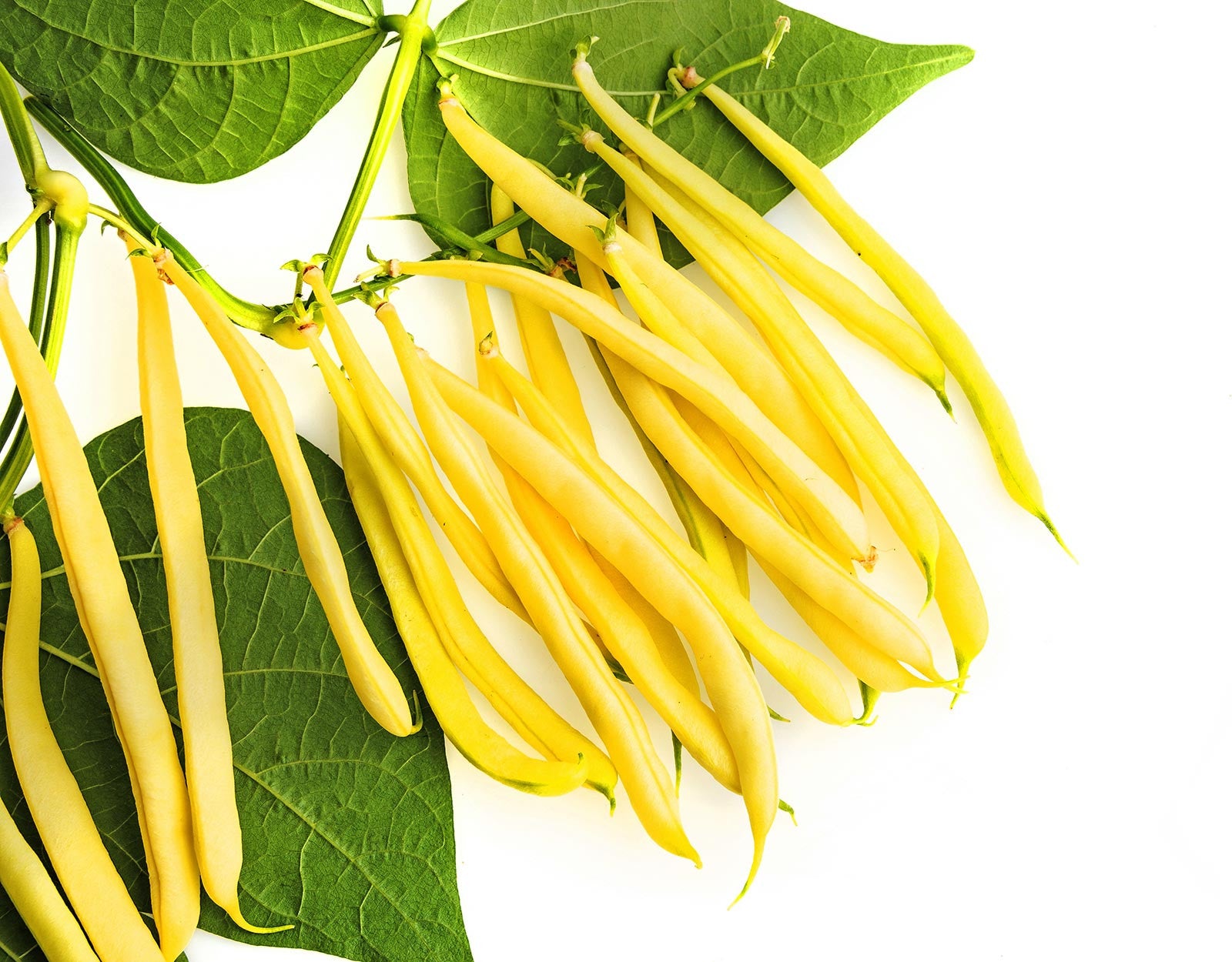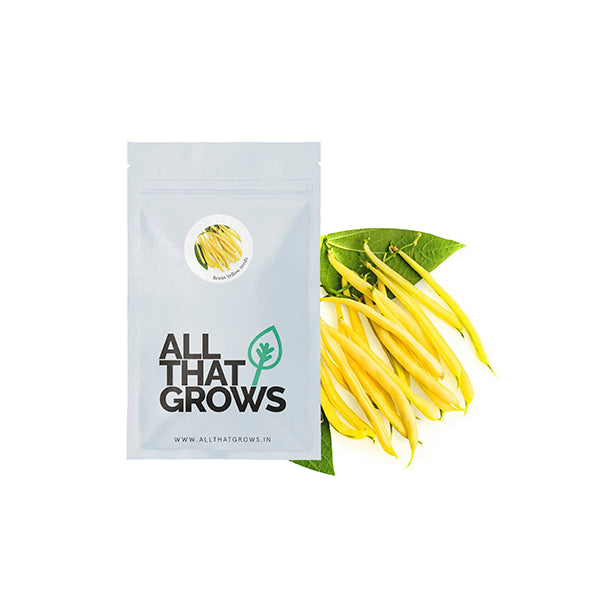



Beans Yellow Seeds
Grow this with
Seed Type : Non-Hybrid, Open Pollinated and Non-GMO
Plant: Dwarf
Sowing time: September to October (plains), May to June ( hills)
Pods: Extra fine ,shining yellow, fibre less, straight
Pod Length: 6-7 inches
First Picking: After 55-60 days from sowing
- SOWING
TIMEPlains: Sep - Oct
Hills: May - June - Sowing
DistancePLANT TO PLANT - 2-4'' LINE TO LINE - 18-36''
- Fruit
WeightN/A
- Fruit
ShapeN/A
- Days to
maturity55 - 60 days
- Details
- How to sow
- Reviews
The ancestors of yellow beans are native to Central and South America. Yellow Wax beans, ideally harvested young, are crisp, succulent and tender-firm, with mellow grassy sweet and nutty flavors. They benefit your health by boosting iron and manganese intake. Both minerals have the ability to activate enzymes, including enzymes needed to produce energy and support your metabolism.They are also rich in Phosphorous, Vitamin C and Vitamin B1.
They stand out, as compared to other beans as french beans, classic green beans and purple beans in salads and alongside several companion ingredients.
Use them to prepare hearty salads by combining with kidney beans, chickpeas, minced onion and a balsamic vinaigrette for healthy three-bean salad, or roast them with summer squash and cherry tomatoes for a roasted summer vegetable salad. You can also roast the beans on their own, adding minced garlic for flavor, or saute them with your favourite vegetables and lean proteins for a healthful stir-fry. Beans can be kept fresh for about 4 days, or blanched and frozen immediately after harvesting.
Planting instructions
Beans can be planted in hills or rows and pole beans will grow on climbing vines. They need a trellis for support.
Do not start seeds indoors as they may not survive transplanting.
Prepare the planting bed by using a garden fork to loosen the soil. For rows, plant the beans at the same depth with spacing about 18-24 inches apart.
Once the seedlings begin to develop true leaves, the plants can be thinned to 6 inches apart. Mulch soil to retain moisture.
Do not rush your bean planting. Seeds planted too soon will be slow to germinate or rot, forcing you to replant again later.
Growing Requirements
watering
Water regularly, from start of pod to set. Water on sunny days so foliage will not remain soaked.
pests
Symptoms may include discoloration, deformation, or abscission, mine or eat holes in the foliage or directly attack the root of the crop. Common pests that attack this crop are Aphids Mexican Bean Beetles Japanese Beetles Cucumber Beetles White Mold Mosaic Viruses Woodchucks Cutworms Bean blossoms will drop from the plant if the weather is too hot and too much nitrogen in the soil will prevent pods from setting.
soil
The plants need well-drained soil with a pH of 6 to 7. Sandy and silty loamy soils are ideal for green beans, although they can grow in almost any soil type except heavy clay.
spot
Bean plants require full sun, at least six hours of sunlight is required daily.
temperature
Seeds can be sown outdoors anytime after last spring frost, minimum soil temp is 8 degrees C (48 F).
how to harvest
Beans are picked at an immature stage, when they are young and tender and the seeds inside have not yet fully developed.
Look for firm, sizable pods and snap or cut off the plant. Do not tear the plant.
Store beans in a moisture-proof, airtight container in the refrigerator. Beans will toughen over time even when stored properly.
Beans can be kept fresh for about 4 days, or blanched and frozen immediately after harvesting.

Customer Reviews
The productiveness of any seed we sell is subject to your local climatic conditions*, the sowing method you adopt, and your commitment to the planting process. We give no warranty, expressed or implied, and are in no way responsible for the produce.
Please note that all our seasonal recommendations/ sowing information is as per the local climatic conditions. *For more information on the optimum conditions required for growing seeds in your region, please contact us at, hello@allthatgrows.in or Whatsapp us at, +91 8544865077
Questions & Answers
Have a Question?
Be the first to ask a question about this.




Beans Yellow Seeds
Seed Type : Non-Hybrid, Open Pollinated and Non-GMO
Plant: Dwarf
Sowing time: September to October (plains), May to June ( hills)
Pods: Extra fine ,shining yellow, fibre less, straight
Pod Length: 6-7 inches
First Picking: After 55-60 days from sowing
Grow this with
The ancestors of yellow beans are native to Central and South America. Yellow Wax beans, ideally harvested young, are crisp, succulent and tender-firm, with mellow grassy sweet and nutty flavors. They benefit your health by boosting iron and manganese intake. Both minerals have the ability to activate enzymes, including enzymes needed to produce energy and support your metabolism.They are also rich in Phosphorous, Vitamin C and Vitamin B1.
They stand out, as compared to other beans as french beans, classic green beans and purple beans in salads and alongside several companion ingredients.
Use them to prepare hearty salads by combining with kidney beans, chickpeas, minced onion and a balsamic vinaigrette for healthy three-bean salad, or roast them with summer squash and cherry tomatoes for a roasted summer vegetable salad. You can also roast the beans on their own, adding minced garlic for flavor, or saute them with your favourite vegetables and lean proteins for a healthful stir-fry. Beans can be kept fresh for about 4 days, or blanched and frozen immediately after harvesting.
Seed Type : Non-Hybrid, Open Pollinated and Non-GMO
Plant: Dwarf
Sowing time: September to October (plains), May to June ( hills)
Pods: Extra fine ,shining yellow, fibre less, straight
Pod Length: 6-7 inches
First Picking: After 55-60 days from sowing
- SOWING
TIMEPlains: Sep - Oct
Hills: May - June - Sowing
DistancePLANT TO PLANT - 2-4'' LINE TO LINE - 18-36''
- Fruit
WeightN/A
- Fruit
ShapeN/A
- Days to
maturity55 - 60 days
Planting instructions
Beans can be planted in hills or rows and pole beans will grow on climbing vines. They need a trellis for support.
Do not start seeds indoors as they may not survive transplanting.
Prepare the planting bed by using a garden fork to loosen the soil. For rows, plant the beans at the same depth with spacing about 18-24 inches apart.
Once the seedlings begin to develop true leaves, the plants can be thinned to 6 inches apart. Mulch soil to retain moisture.
Do not rush your bean planting. Seeds planted too soon will be slow to germinate or rot, forcing you to replant again later.
Growing Requirements
watering
Water regularly, from start of pod to set. Water on sunny days so foliage will not remain soaked.
pests
Symptoms may include discoloration, deformation, or abscission, mine or eat holes in the foliage or directly attack the root of the crop. Common pests that attack this crop are Aphids Mexican Bean Beetles Japanese Beetles Cucumber Beetles White Mold Mosaic Viruses Woodchucks Cutworms Bean blossoms will drop from the plant if the weather is too hot and too much nitrogen in the soil will prevent pods from setting.
soil
The plants need well-drained soil with a pH of 6 to 7. Sandy and silty loamy soils are ideal for green beans, although they can grow in almost any soil type except heavy clay.
spot
Bean plants require full sun, at least six hours of sunlight is required daily.
temperature
Seeds can be sown outdoors anytime after last spring frost, minimum soil temp is 8 degrees C (48 F).
how to harvest
Beans are picked at an immature stage, when they are young and tender and the seeds inside have not yet fully developed.
Look for firm, sizable pods and snap or cut off the plant. Do not tear the plant.
Store beans in a moisture-proof, airtight container in the refrigerator. Beans will toughen over time even when stored properly.
Beans can be kept fresh for about 4 days, or blanched and frozen immediately after harvesting.



 Sign In
Sign In







